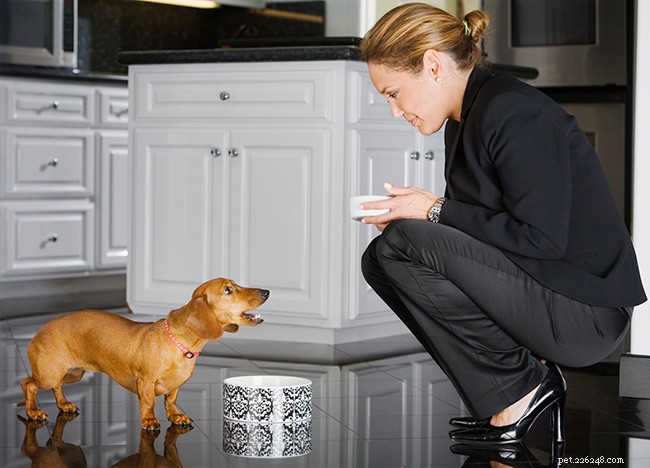Por que os cães latem e como lidar com isso

Quase todos os cães latem. É uma de suas principais formas de comunicação vocal, e tem sido útil em sua evolução e até mesmo em seu papel como companheiros de casa modernos, como quando eles estão alertando você para um perigo percebido ou precisam ser soltos no penico.
Não é razoável esperar que um cachorro nunca ladre, mas quando esse latido se torna excessivo ou problemático para outros membros da família ou vizinhos, é hora de agir para contê-lo. Se o latido excessivo é um problema em sua casa, o primeiro passo é descobrir por que seu cão está latindo tanto.
Os cães latem por vários motivos, e isso pode significar coisas diferentes dependendo da situação.
Os cães latem para:
- Chame nossa atenção.
- Alerte-nos sobre uma possível ameaça.
- Deixe-nos saber que eles precisam ir ao banheiro.
- Anunciar que eles gostariam de ser alimentados.
- Avisar outro cachorro para recuar.
- Diga a outro cachorro da casa que ele é o responsável.
- Diga-nos para jogar a bola.
- Mostre que eles estão se divertindo jogando.
Aqui estão detalhes sobre os diferentes tipos de latidos e como lidar com aqueles que precisam de ação:
O que é latido de atenção ?
Os cães podem latir para chamar sua atenção. Eles estão dizendo:'ei, olhe para mim', brinque comigo ou me acaricie. O comportamento de busca de atenção do cão é comum - e se desenvolve como uma habilidade de sobrevivência quando são filhotes que dependem totalmente dos cuidados de sua mãe.
Como parar de latir por atenção
Não reconheça seu cão, o que significa que não olhe para ele, fale com ele ou diga seu nome. Se você reconhecê-los, você incentivará o comportamento, sem querer, pois seu cão terá sucesso em chamar sua atenção. A melhor opção é simplesmente sair da sala e fechar a porta atrás de você para que eles não possam segui-lo. Fique fora da sala por dois ou três minutos e, quando voltar, não preste atenção neles por alguns minutos.
Pode levar algumas semanas, ou até mais, para quebrar o seu cão dessa tática de busca de atenção, especialmente se eles tiverem sucesso por um longo tempo. Seja paciente e consistente, e seu cão aprenderá que latir não é mais uma maneira eficaz de atrair atenção.
O que é latido de alerta?
Quando seu cão late para alguém que passa por sua casa ou quintal, eles estão alertando você sobre o que eles percebem ser uma ameaça em potencial. Não importa se você pensa nisso como uma ameaça, seu cão sempre agirá por instinto para proteger sua família. Em vez de ficar frustrado quando eles latem, tente entender que eles estão dizendo:'Perigo, perigo!'
Se você abordar o latido de alerta deles com frustração, isso só aumentará a crença de que eles precisam continuar latindo enquanto você está exalando ansiedade. É importante responder com calma e com a compreensão de que seu cão está realmente estressado e tentando fazer seu trabalho como membro da família para ajudar a protegê-lo.
Como lidar com latidos de alerta de forma eficaz

1. Após o primeiro latido - Diga, 'Obrigado' e use o nome do seu cão, para que eles saibam que você está respondendo a eles. É crucial responder usando essas palavras, pois em nossa cultura fomos ensinados a dizer “obrigado” com um tom calmo e agradecido. Isso ajuda você a lembrar que seu cão está apenas tentando ajudar e seu tom é calmo, o que é particularmente importante ao responder. Se o seu cão parar de latir depois disso, você não precisa ir para a próxima etapa.
2. Espere 20 segundos depois de dizer "Obrigado." Se o seu cão ainda está latindo, isso significa que ele ainda está preocupado com o perigo. Don’t acknowledge them, walk over to the window they are barking at, look through the window as if you are checking out the potential threat. Then turn around and yawn without acknowledging your dog. This shows your dog that there is nothing to worry about. Go back to what you were doing.
3. Wait 30 seconds, and if your dog continues to bark, this means they don’t believe you are capable of making that decision and still feel responsible for making the danger go away. Without making a fuss, slip a leash over their head and calmly take them to another small room, preferably a bathroom or laundry room. If they are afraid of the bathroom or laundry room, use a different place for a time out. Puppy proof the room, turn on the light, and if you are concerned about your dog scratching on the door, put some cardboard or plywood in front of the door before you close it. Remove the leash and leave your dog in the room for three minutes. This gives your dog a chance to calm down and is a reminder that it’s not their job to protect you. If they are scratching, barking or whining, wait for a 10-second pause, then open the door and let them out of the room. Again, don’t give them any special attention.
Addressing alert barking with multiple dogs in the home
If there is more than one dog in your home, and both dogs are still barking after step two, the dog who initiated the alert barking goes to a time-out. If the second dog stops after taking the first dog to his time out, you don’t need to do anything. But if the second dog continues barking, they are put in a different room for three minutes.
Your dog will ALWAYS bark to alert you of a threat; it’s in their nature. By following these three steps, your dog will understand that you are in charge and they don’t need to worry. These actions are based on how dogs think and perceive leadership, and after time they will be less intense in their barking and will stop more quickly.
With patience and consistency in your response, your dog shouldn’t escalate to the time outs.
Barking to communicate a need to go to the bathroom
Some dogs will bark to announce, “I need to go potty.” It’s always essential to honor your dog’s request to eliminate.
If your dog barks for this reason, try to appreciate your dog’s call for help, as they are communicating a need in the best way they know how. Calmly walk over to the door and let them out to go potty.
Dogs may not bark when they need to go. They may just stand by the door or circle, pace, whine or paw at the door. Even without barking, let them out regularly to avoid any accidents or discomfort.
Barking to say ‘feed me now!’

While it may seem cute that your dog is ringing the dinner bell, so to speak, this behavior can be a sign of underlying stress.
If you feed your dog when they demand it, whether by barking or other attention-getting behaviors, your dog will believe that they are in charge of the food. This can lead to behavioral issues such as:
- One dog intimidating another away from the food bowl
- Being possessive over their food/bones
- Waking you up earlier and earlier to feed them
- Begging while you eat
- Demanding attention
- Persistent demands to play with them
The easiest way to address this behavior is to ignore their demand to be fed. Wait until they have stopped trying to get your attention for a while, then feed them. I also recommend changing up their mealtimes by 1 ½- 2 hours. Creating a two-hour window, whenever possible, breaks the habit of your dog expecting to be fed at a particular time in your routine. Eventually, they will stop demanding to be fed, and instead of being woken up by your dog earlier than you’d like, you will be able to sleep in!
Warning bark to say ‘back off’ or tell another dog they are in charge

When multiple dogs live in a home, they will sometimes bark at each other to communicate that they want all of the attention. For example, one dog may be getting some affection, then another dog comes over to get attention, and the first dog warns the second dog to back off with a bark. This can be a sign of possessive behavior towards the human and must be addressed.
You must decide when affection is given, especially with multiple dogs in the home, so that one dog doesn’t monopolize your attention. If you allow one dog to push the other dog or dogs out of the way, it can lead to the other dogs feeling like they are walking on eggshells. This can lead to other behavioral issues. You should be able to call a dog over to you without either dog reacting negatively.
When a dog is afraid of another dog in the home, they may:
- Be reluctant to come over to you.
- Slink over to you.
- Be watching the other dog’s movements as they are getting affection.
- Not be able to settle and enjoy your attention, as they fear being reprimanded by the other dog.
If a dog is feeling possessive of you, they are likely to:
- Stay by your side.
- Keep a constant eye on the other dogs in the home.
- Bark, snarl, growl, or even lunge at another dog who tries to approach in warning to back off.
How to address barks that say ‘back off’ to another dog
If your dog exhibits this behavior, it’s helpful to have a leash attached to their collar for easy access so that you can address the action quickly. Of course, you need to ensure that someone is monitoring the dog, so they don’t get tangled in the leash and hurt themselves. If the possessive dog shows signs of telling another dog to back off as you or another family member are giving them attention, they need to be immediately and calmly removed from the room. Step on the leash, don’t look at or talk to the dog, remain calm and matter-of-fact in your energy, and pick up the leash.
Then, escort the dog to the bathroom or laundry room to be separated from everyone. Turn on the light, remove the leash, and leave them alone in the room for three to five minutes. After three minutes, open up the door, put the leash on, with no acknowledgment, and let them out. If they are barking, whining, or scratching on the door, it’s crucial to wait for a 10-second break in the barking, whining or scratching, then open the door. If not, they will think they were let out because they were complaining, and that reaction will escalate.
Some dogs need to be walked on a leash back into the room with the other dogs, or they could go straight to the other dog and lunge again. Don’t drop the leash until the dog’s energy is calm and relaxed. You set the room’s tone by creating as much safety and calm energy as possible, bringing the stress level down, making it easier for the dogs to feel relaxed.
If they have separation anxiety, three minutes is adequate. You don’t want them to get stressed being separated for too long. However, if the dog is assertive and confident, they usually require four to five minutes of separation to digest the message.
Why separation works
The reason for separation is that dogs understand this consequence as if they were part of a pack on the street or in the wild. If they made a mistake in the pack, essentially challenging the leadership, they would be reminded that they were not in charge of making decisions. They would be shunned from the rest of the pack for a while. As they are now living in our homes, we are their pack, so this consequence makes sense to them. When done consistently, we will teach them their behavior is unacceptable.
It’s vital to ensure that you give each dog in your home attention and that they all feel included. By calling them to you for affection, you are showing them that you are in charge of when they receive attention and that one of them isn’t more important or higher ranking than the other.
This allows all of your dogs to feel comfortable and relaxed with you and in general. Remember, even for a dog who may be bullying, they are feeling stressed, or they wouldn’t be exhibiting that behavior.
Barking used to control other dogs in the home
Dogs can bark to show another dog that they are in charge in other ways:
- Barking to say, “This is my water bowl, and you can’t come over here to get a drink.”
- Acting like the ‘troll’ at the bridge, not allowing other dogs to pass them to walk into a room. They may bark, but they could also growl, snarl, or lunge to exert their control.
Addressing barking as a controlling behavior
For any controlling behavior like this, it’s essential that it’s addressed every time and that you don’t let the dogs work it out between them. You must always show that you are in charge and that it’s never OK for any of your dogs, no matter their age, to try to control another dog in the home.
Just like you wouldn’t let kids fight; an adult would step in to resolve the conflict. For any attempt to control another dog in the home, the dog asserting themselves should be immediately and calmly separated for a time out, as previously described.
Once the issue has been resolved, the atmosphere in the home will change:
- The dogs will start enjoying each other’s company more.
- Dogs may lay closer to each other, even share a dog bed.
- They may start playing with each other.
- Dogs may play with toys more often.
- They will enjoy your affection on a deeper level.
Barking to tell us to throw the ball or they are having fun playing
Dogs use their voice and bark to say “throw the ball!” and to express that they are having fun.
While this is probably the best kind of barking to a pet parent, it’s important that you are in charge of the playtime, meaning that you:
- Decide when playtime starts and ends.
- Establish the rules of the game.
Your dog is in charge of playtime if they:
- Bring balls/toys to you all evening to throw for them.
- Bark at you if you stop throwing the ball or toy.
How to stop play-related demand barking

The easiest way to stop this behavior is simply putting the ball or toy out of sight when you are finished playing the game.
I also recommend adding rules to the game; the more you establish that you are creating the rules for playtime, the less your dog is likely to try to make up their own rules.
For example, if you want to play fetch, ask them to ‘sit’ before you even throw the ball, requiring them to show self-control. Then as you throw it, ask them to ‘fetch’. Once they have picked it up, say, “good fetch, bring it.” If they bring it to you, then say, “good bring it, drop it.”
It’s easier to teach them to drop it, in the beginning, if you exchange the ball for a treat. Once they bring it and you have praised them, hold the treat in front of them, as you ask them to “drop it”. As soon as they drop the ball, pick it up with one hand, as you give them a treat with the other and say, “good, drop it.”
This keeps your dog’s focus on you and what you expect from them to continue playing the fetch game. If they are barking in the joy of the game, but not being demanding, keep playing.
If they start demanding that you throw it, you can walk back inside and put the ball away, ending the game if you like. Another option is to wait until they have stopped barking, then throw the ball. The goal is that you define the rules of the game.
Sarah-Anne Reed is a holistic dog trainer, and owner of Pack Dynamics, LLC ®. Her practice focuses on understanding and respecting dogs as a different species and honoring them as individual beings.
This article is copyrighted by Sarah-Anne Reed and Pack Dynamics ® LLC, and no reproduction of this article without the express permission of Sarah-Anne Reed, is permitted.
Are you someone who takes dog training seriously? Then you are a great candidate for pet insurance. Get a quote and make sure you’re covered for future injuries or illnesses.

